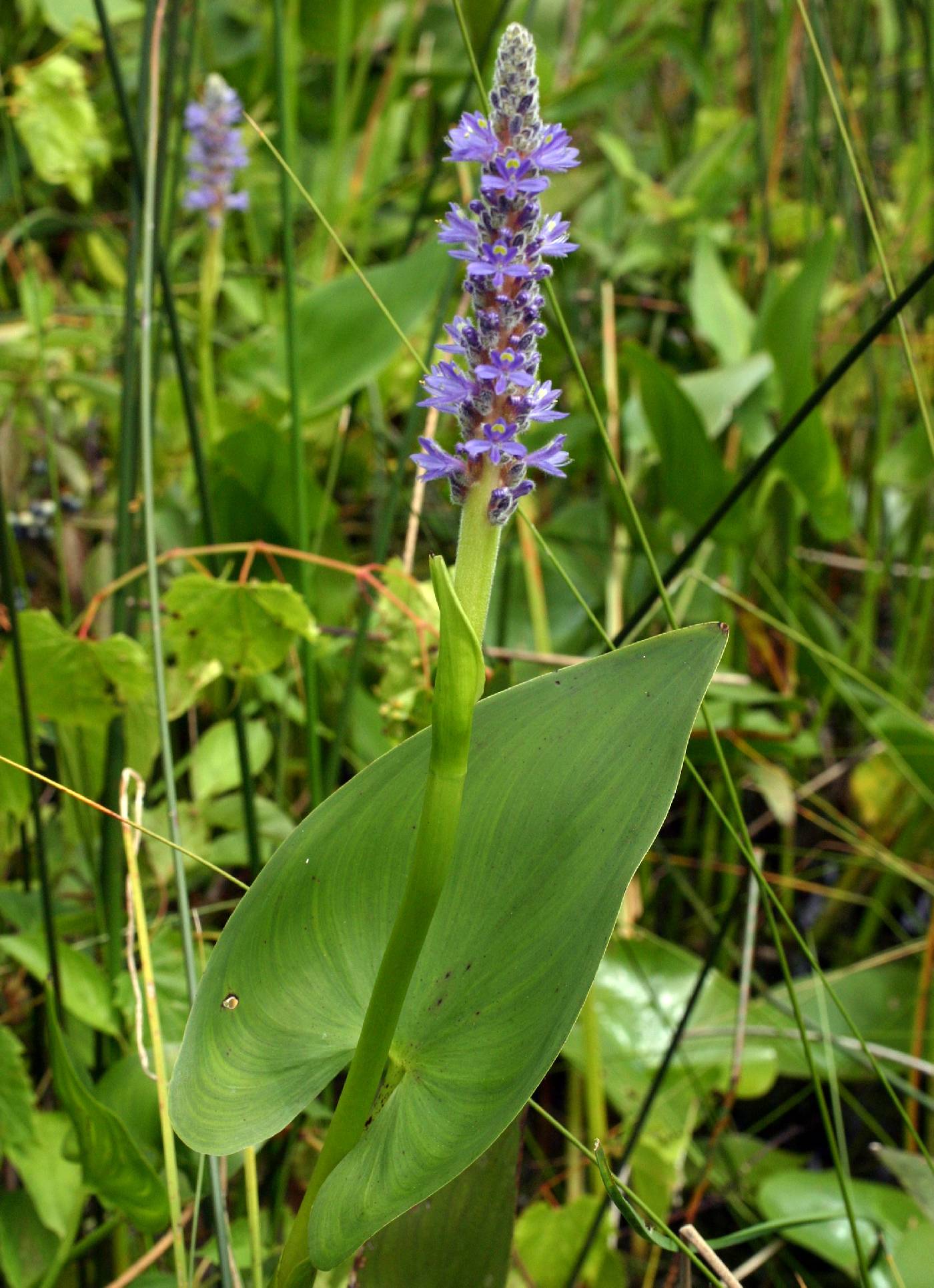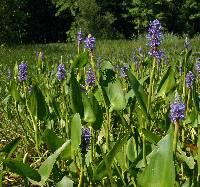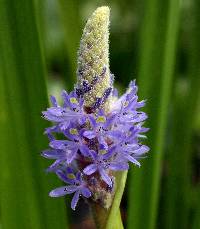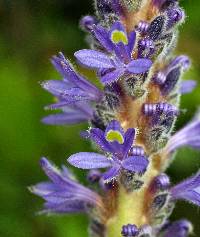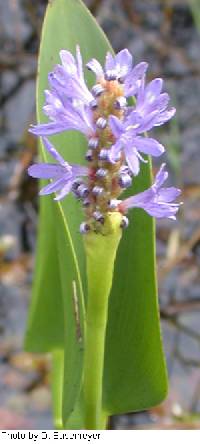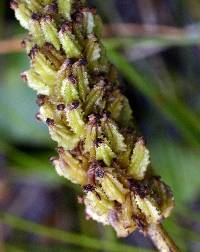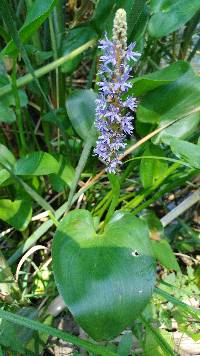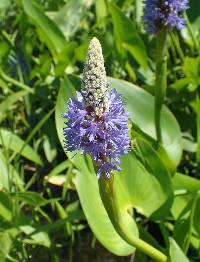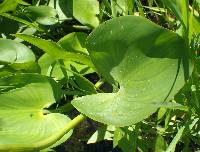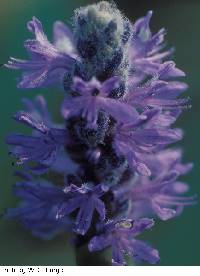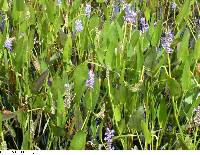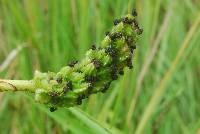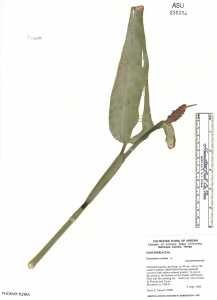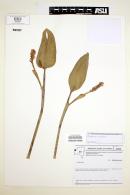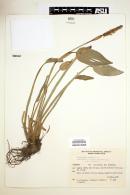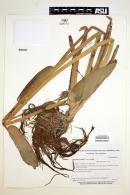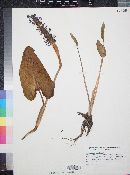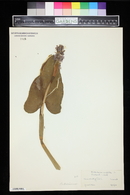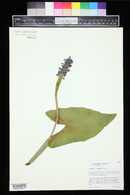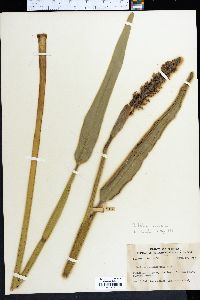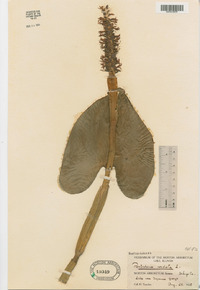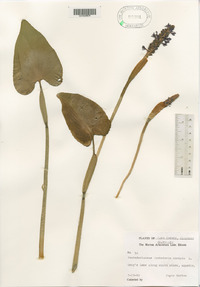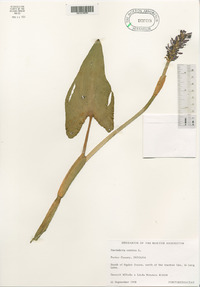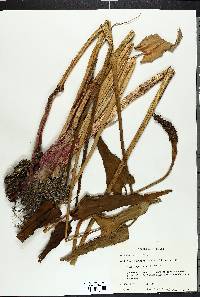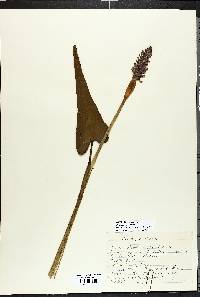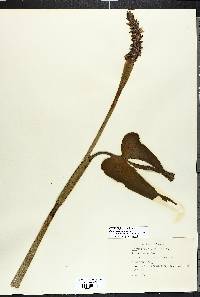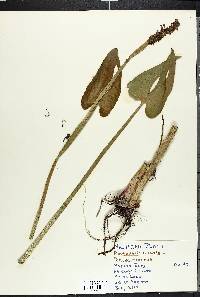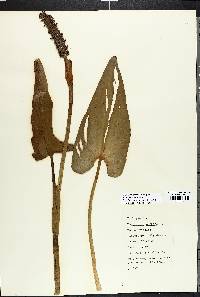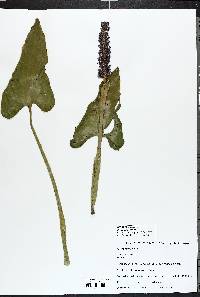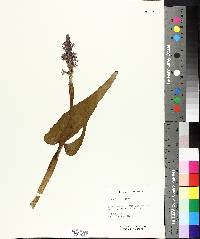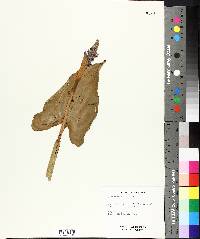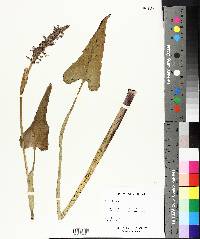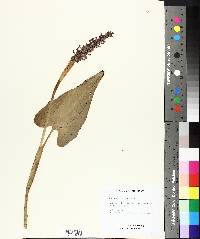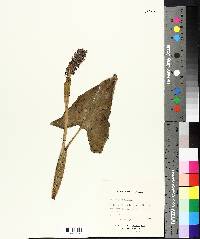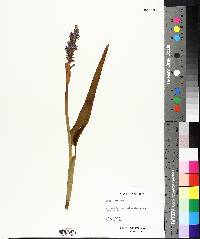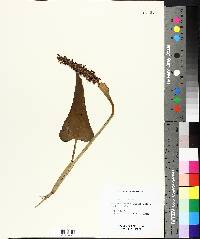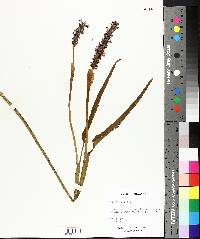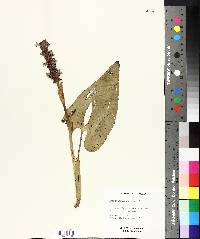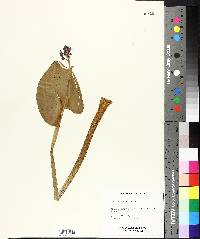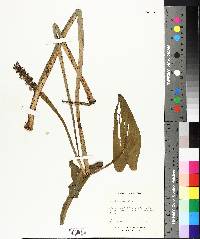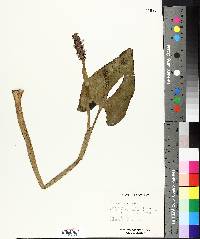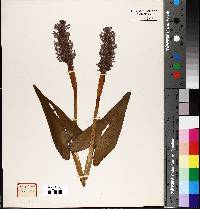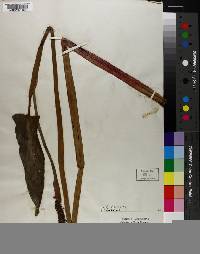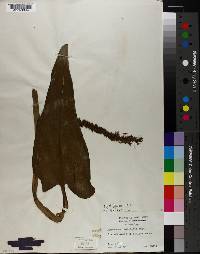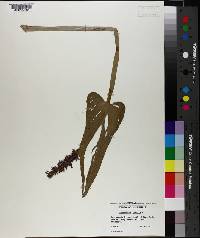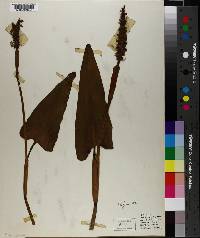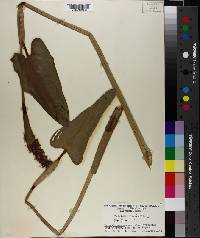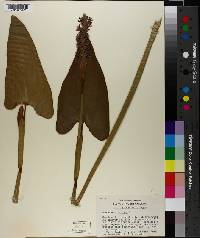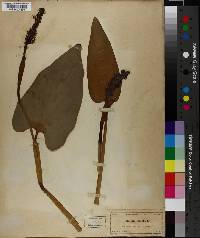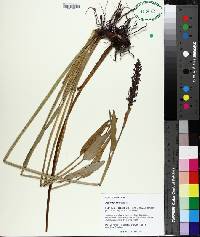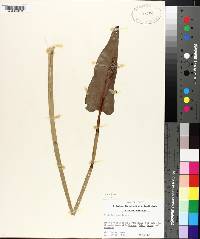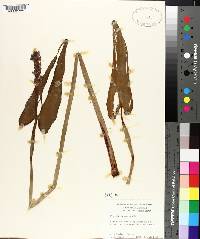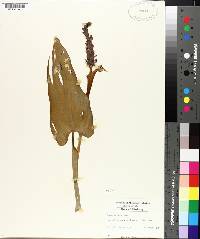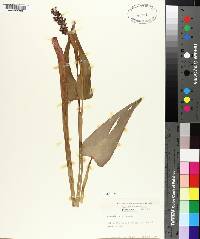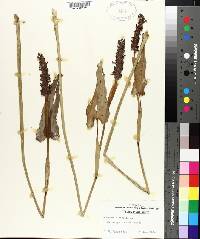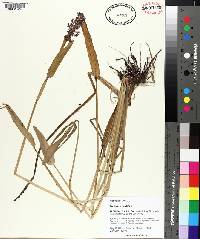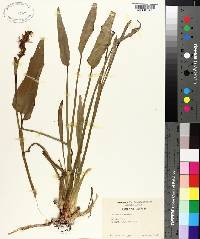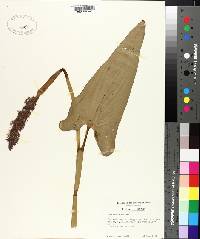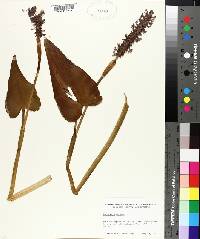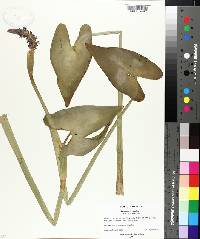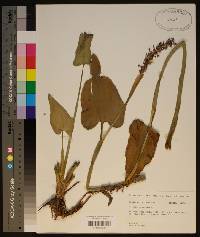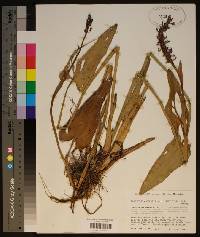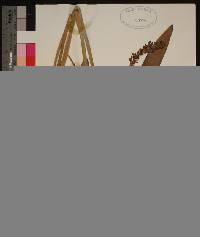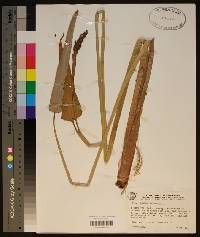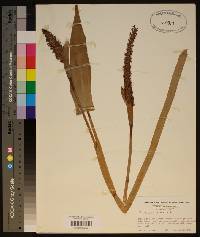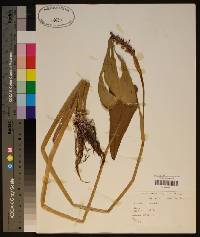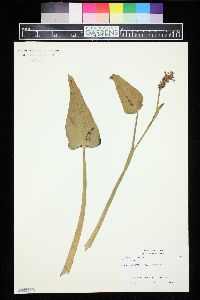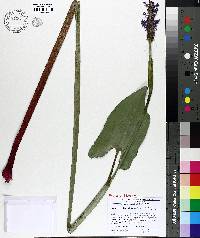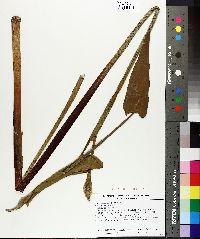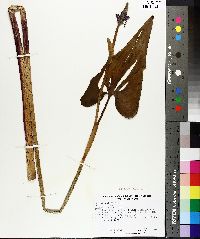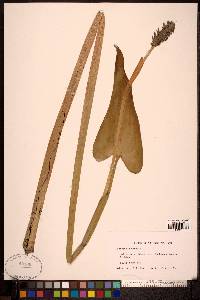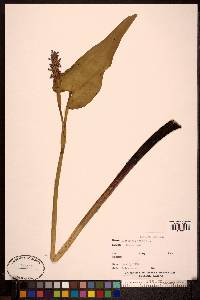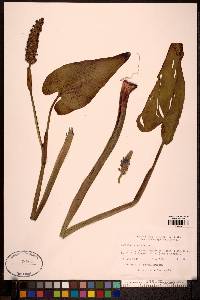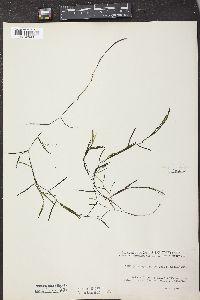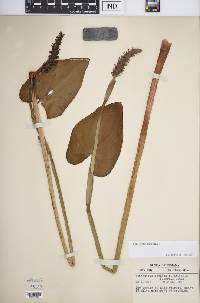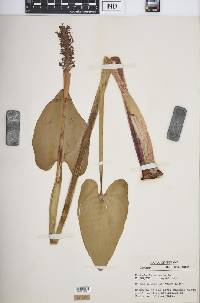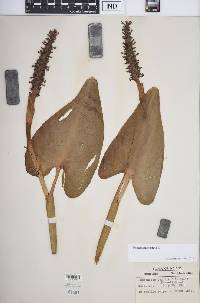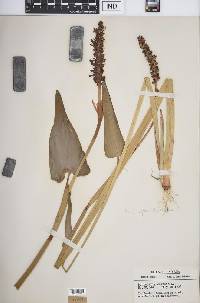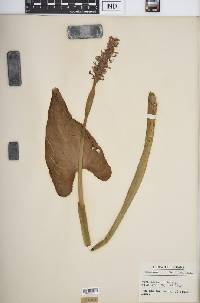Pontederia cordata
|
|
|
|
Family: Pontederiaceae
Pickerelweed
[Pontederia cordata f. angustifolia (Pursh) Solms, morePontederia cordata f. latifolia House, Pontederia cordata f. taenia Fassett, Pontederia cordata var. albiflora , Pontederia cordata var. angustifolia (Pursh) Torr., Pontederia cordata var. cordata , Pontederia cordata var. lanceolata (Nutt.) Griseb., Pontederia cordata var. lancifolia (Muhl.) Morong, Pontederia lanceolata Nutt., Pontederia lanceolata f. trullifolia Fernald, Pontederia nymphaeifolia Kunth, Unisema media] |
Perennial aquatic herb 15 cm - 1.2 m tall Leaves: of two types: a basal rosette of stalkless, linear leaves, which are normally underwater; and emergent, stalked (up to 60 cm), lance- to heart-shaped, 6 - 22 cm long, 0.7 - 12 cm wide stem leaves with a 7 - 29 cm long stipule. The leaf stalks of the emergent leaves are distinctly constricted just below the blades. Veins of leaf blades all parallel, curved, and never with netlike veins between them. Inflorescence: a long-stalked, elongate spike (2 - 15 cm long) of fifty to several hundred, stalkless flowers. The inflorescence stalk is glandular-hairy or long, silky-hairy, and the upper part of the stalk has a 5 - 17 cm long bract folded around it. Flowers: numerous, stalkless, mauve, 4 - 12 mm long, 1 - 1.6 cm wide, bilaterally symmetric, two-lipped, but generally funnel-shaped with spreading lobes. The flowers are only open for one day. Stamens: six, but of two lengths: the upper three short (1.5 - 6.3 mm long), and the lower three longer (0.7 - 1.3 cm long). Filaments purple, and glandular-hairy. Anthers yellow, and egg-shaped to oblong. Pistil: with one, three-chambered, superior ovary; and one, three-lobed style. Fruit: a spike of numerous, single-seeded, single-chambered, egg-shaped, 4 - 6 mm long, 2 - 3 mm wide, bladder-like units (utricles), which have longitudinal, toothed ridges. Stems: of two types: rhizome-like, contracted, vegetative stems, which are submersed underwater; and erect, flowering stems, which are slightly constricted just below the first node. Tepals: six, but fused into a 3 - 9 mm long tube, then separating into 5 - 8 mm long, inversely lance-shaped, pointy-tipped lobes, which together appear as an upper three-lobed lip, and a lower three-lobed lip. The tepals are covered with glandular or long, silky hairs, and while all tepals are mauve, the upper, central lobe has a distinctive, two-lobed, yellow spot. Similar species: If only the leaves of Pontederia cordata are present, it could possibly be mistaken with some other common aquatic herbs such as Alisma triviale, A. subcordatum, Echinodorus berteroi, or even Sagittaria rigida and S. graminea, but all the leaves of those species have netlike veins running between the major lengthwise parallel veins. Once flowers are present, those species are rather unlike P. cordata because they have stalked flowers, many have branched inflorescences, and all have three obvious and separate sepals, three petals, and at least six pistils that form small or large fruiting heads of achenes. Another broad-leaved aquatic plant that is more closely related to P. cordata (in the same family) is the aggressive invasive Eichhornia crassipes, or water hyacinth. This species has been reported in the Chicago Region a few times, but it cannot survive through the winters. It differs from P. cordata by having more rounded and very leathery leaf blades, very inflated and almost bladder-like leaf stalks, larger flowers (over 2 cm wide), and capsules for fruit. Flowering: June to September Habitat and ecology: Somewhat rare, close to shores and in shallow water of lakes and slow-moving streams, also in shallow open water of bogs. Occurence in the Chicago region: native Notes: This is the only species of Pontederia in North America, and it extends south into Mexico, Central America, and South America. There can be much variation in leaf shape within populations and even on single plants. Author: The Field Museum Erect or nearly so, to 10 dm; basal lvs and lower stem-lf similar, long- petioled, the blade firm, broadly cordate to lanceolate, to 18 cm; spathe loosely sheathing, 3-6 cm; infl crowded, 5-15 cm; perianth funnelform, villous or shortly glandular-pubescent in bud, later often glabrate, violet-blue, rarely varying to white, the tube 5-7 mm, the lobes 7-10 mm; filaments pubescent; fr 5-10 mm, longer to sometimes shorter than wide; 2n=16. Marshes and shallow water; N.S. to Ont. and Minn., s. to S. Amer. (P. lanceolata) Gleason, Henry A. & Cronquist, Arthur J. 1991. Manual of vascular plants of northeastern United States and adjacent Canada. lxxv + 910 pp. ©The New York Botanical Garden. All rights reserved. Used by permission. From Flora of Indiana (1940) by Charles C. Deam This species is frequent throughout most of the lake area but is absent or very local south of it. It must have its base in water most of the time, but otherwise it does not seem particular as to where it grows. It seems to grow nearly as well in almost pure marl areas as in sandy, muddy, and mucky borders. However, I find the largest specimens in mucky borders of lakes. The trimorphic flowers of this species are interesting to one who can give the time to their study. …… Indiana Coefficient of Conservatism: C = 5 Wetland Indicator Status: OBL |
|
|
|

